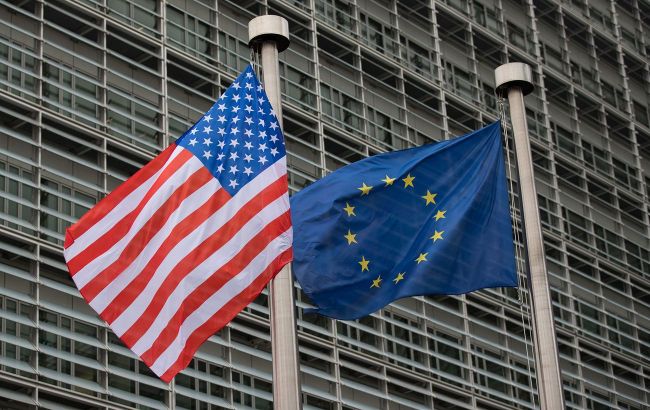EU greenlights Trump’s tariff rate, but sets conditions for US
 The EU seeks advantageous positions in talks with the US and is prepared for countermeasures after July 9 (Photo: Getty Images)
The EU seeks advantageous positions in talks with the US and is prepared for countermeasures after July 9 (Photo: Getty Images)
The European Union is prepared to implement a universal export tariff on goods shipped to the US, but only in exchange for reduced tariffs on products from several strategic sectors, according to Bloomberg.
Sources close to the negotiations say Brussels is willing to agree to a trade deal with the US that includes a universal 10% tariff on a large portion of European exports.
At the same time, the EU insists on reduced tariff rates for certain key sectors, such as pharmaceuticals, alcoholic beverages, semiconductors, and civil aviation.
Additionally, the EU is pushing the US to introduce quotas or exemptions that would reduce existing tariffs: 25% on cars and auto parts, and 50% on steel and aluminum.
The European Commission, representing the EU in trade talks, views the proposed deal as somewhat more favorable to the US, but overall acceptable to Brussels.
Bloomberg reminded that the EU has until July 9 to reach a trade agreement with President Donald Trump before tariffs on nearly all European exports to the US increase to 50%.
According to the Vienna Institute for International Economic Studies, EU countries exported cars and auto parts worth €52.8 billion to the US in 2024, making the US the largest market for this sector.
Steel and aluminum exports totaled €24 billion last year, with Germany, Italy, and France as the main exporters.
Progress of negotiations and key proposals
The EU and the US remain confident they can reach an interim agreement by July 9, which would allow talks to continue beyond that date. The expected document will address both tariff and non-tariff barriers, procurement of key American goods, and outline areas of strategic cooperation.
According to sources, this week, Vice President of the European Commission and Head of External Trade, Maroš Sefcovic, will lead a delegation to Washington to advance the negotiations.
The European Commission emphasizes that the optimal outcome remains reaching a broad agreement in principle, although it is currently impossible to predict the exact duration or terms of any interim deals.
The EU also insists that existing and planned US sectoral tariffs, particularly on automobiles and metals, be addressed at the initial stage of negotiations.
As part of the discussions, the parties are also addressing non-tariff barriers, which the EU proposes to tackle through an initiative aimed at simplifying procedures. Additionally, they are exploring opportunities for strategic procurement in key sectors such as liquefied natural gas and artificial intelligence technologies.
The EU has also expressed willingness to cooperate with the US on shared challenges related to economic security. According to Brussels’ estimates, current US tariffs cover approximately €380 billion - about 70% of total European exports to the United States.
On Monday, June 30, the European Commission received a US proposal covering tariffs, non-tariff barriers, and areas of strategic cooperation. However, sources say the specific details, including possible tariff rates, were not disclosed to EU member states.
Four scenarios and the EU’s countermeasures
According to sources, ahead of the July 9 deadline, Brussels is considering four possible outcomes:
- Reaching an agreement with an acceptable level of asymmetry;
- Receiving an unacceptable, one-sided proposal from the US;
- Continuing negotiations beyond the deadline;
- Trump is withdrawing from talks and sharply increasing tariffs.
If the last scenario unfolds, the EU is prepared to take all possible countermeasures.
At the same time, preparations are underway for a potential response in case the negotiations fail.
Brussels has already approved a list of tariffs totaling €21 billion on American goods that could be quickly implemented in response to US metal restrictions. The list includes politically sensitive products for the US, such as Louisiana soybeans (from the state represented by House Speaker Mike Johnson), agricultural products, poultry meat, and motorcycles.
Additionally, the EU has prepared a further tariff list amounting to €95 billion targeting American goods in response to the so-called mirror tariffs imposed by Trump and US tariff policies on automobiles. Potential targets include industrial goods such as Boeing aircraft, American-made cars, and bourbon.
Furthermore, Brussels is consulting with member states to identify strategic sectors where the US depends on the EU, as well as potential measures beyond tariffs, such as export controls and restrictions on American companies’ participation in public procurement.
“The EU, which has been seeking a mutually beneficial deal, will assess any end result and at that stage decide what level of asymmetry it’s willing to accept,” Bloomberg reported.
US customs tariff war
On April 2, US President Donald Trump imposed tariffs on imports from over 180 countries, ranging from 10% to 49% depending on the country of origin and the category of goods and raw materials.
Specifically, the US set a 25% tariff on steel and aluminum imports from EU countries. In response, Brussels imposed retaliatory tariffs on American imports worth a total of €21 billion.
However, on April 9, Trump established a uniform 10% tariff for all countries, effective for 90 days. This rate will remain in place until July 9, by which time Washington aims to sign individual trade agreements with each country, clearly outlining tariff rates.
For the EU, Trump reduced the tariff to 10% starting April 9, and the EU postponed imposing its own 25% tariffs for 90 days, expressing readiness to negotiate.
Recently, however, Trump indicated he will not delay implementing tariffs for countries that fail to reach individual trade agreements with the US by July 9.

